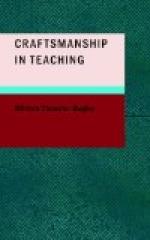But, even at its best, the task is a severe one, and we need, here as elsewhere in education, carefully controlled tests and experiments, that will enable us to get at the facts. Above all, let me protest against the incidental theory of teaching pupils how to study. To adopt the incidental policy in any field of education,—whether in arithmetic, or spelling, or reading; whether in developing the power of reasoning or the memory, or the art of study,—is to throw wide open the doors that lead to the lines of least resistance, to lax methods, to easy honors, to weakened mental fiber, and to scamped work. Just as the pernicious doctrine of the subconscious is the first and last refuge of the psycho-faker, so incidental learning is the first and last refuge of soft pedagogy. And I mean by incidental learning, going at a teaching task in an indolent, unreflective, hit-or-miss fashion in the hope that somehow or other from this process will emerge the very definite results that we desire.
FOOTNOTES:
[Footnote 14: A paper read before the Superintendents’ Section of the Illinois State Teachers’ Association, December 29, 1910.]
IX
A PLEA FOR THE DEFINITE IN EDUCATION[15]
I
One way to be definite in education is to formulate as clearly as we can the aims that we hope to realize in every stage of our work. The task of teaching is so complex that, unless we strive earnestly and persistently to reduce it to the simplest possible terms, we are bound to work blindly and ineffectively.
It is only one phase of this topic that I wish to discuss with you this morning. My plea for the definite in education will be limited not only to the field of educational aims and values, but to a small corner of that field. Your morning’s program has dealt with the problem of teaching history in the elementary school. I should like, if you are willing, to confine my remarks to this topic, and to attack the specific question, What is the history that we teach in the grades to do for the pupil? I wish to make this limitation, not only because what I have to say will be related to the other topics on the program, but also because this very subject of history is one which the lack of a definite standard of educational value has been keenly felt.
I should admit at the outset that my interest in history is purely educational. I have had no special training in historical research. As you may perhaps infer from my discussion, my acquaintance with historical facts is very far from comprehensive. I speak as a layman in history,—and I do it openly and, perhaps, a little defiantly, for I believe that the last person to pass adequate judgment upon the general educational value of a given department of knowledge is a man who has made the department a life study. I have little faith in what the mathematician




